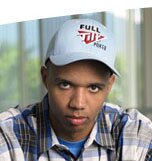Howard Lederer
March 6, 2006
Many of the people crowding the tournament circuit these days developed their interest in serious poker from watching broadcasts of the World Poker Tour and the World Series of Poker. With hole cards shown as the hands are played out, viewers get to see how the best players in the world ply their craft. They can then apply the lessons they've learned in their own play.
In the last couple of years, I've noticed that some of the less experienced players who have entered $10,000 buy-in tournaments don't fully appreciate what they've seen on TV. Many are apt to misapply the techniques they've witnessed. As a result, these players find themselves on the rail early, wondering why a move that worked so well for Phil Ivey or Chris Ferguson had such disastrous results for them.
To avoid falling into this trap yourself, take note of two key pieces of information the next time you sit down to watch the WPT or WSOP: The number of players at the table and the stack sizes relative to the blinds.
World Poker Tour final-table broadcasts start when six players remain. Through the vast majority of tournaments, however, tables are nine or 10-handed. When 10 people are at the table, you always need to be concerned that someone holds a big pocket pair or Ace-King. As a result, most good players tend to be cautious at full tables. They won't get themselves in a lot of trouble with speculative hands like a middle pocket pair or Ace-10. At a short-handed table, however, the chances of running into a big hand are greatly diminished. When play is three- or four-handed, a pro will likely play a hand like pocket 9s very aggressively.
Usually, in the late stages of tournaments, the blinds are extremely high when compared to the size of the stacks. For example, in the recent WPT event from the Gold Strike in Tunica, when four players remained, the average stack had about 1.4 Million in chips. This may sound like a lot but, at that time, the blinds were 30,000 and 60,000 with a 10,000 ante. The short stacks, who had less than 1 Million each, couldn't afford to be patient. If they failed to play for a mere 20 hands, their stacks would be cut in half.
As blinds increase, good players get more aggressive, making frequent pre-flop raises while attempting to steal the blinds and antes. They know that if they sit and wait for top-quality hands, the blinds and antes will decimate their stacks. At these stages of tournaments, you'll see a lot of attempted steals with second-rate hands. Other good players, fully aware that their opponents may be raising with very little, might re-raise or fight back from the blinds with similarly modest holdings.
Short tables and high blinds create settings that necessitate near constant aggression and continual action. So, for example, when you see a pro re-raise all-in from the blinds with pocket 7s, it's likely he's properly considered the situation and has made the best available play. He's thought about the short table and high blinds, determined that he probably has the best hand and, most importantly, that his opponent likely can't call the re-raise. The same player would treat the same hand very differently at an earlier stage of the tournament.
The final factor to consider when watching televised poker is that the shows are highly edited. At this year's WSOP, it sometimes took 15 hours and hundreds of hands to determine a winner. On ESPN, they usually include about 20 hands in an hour-long broadcast. So, you can be sure that much of the context if missing from these telecasts. A call or re-raise that seemed odd on TV may have made perfect sense in the course of the event. For instance, if an aggressive player raised eight consecutive times on the button, the big blind may have decided that he had to fight back with rags, just to let his opponent know that he was willing to take a stand. It's not a play that person would normally make, and it may look strange on TV but, in context, the re-raise with 8-high made perfect sense.
I suggest that you TiVo the next poker event you plan to watch. Keep track of the number of players and the size of the blinds. By paying attention to the details, the big picture will likely become clearer.
Howard Lederer
|



